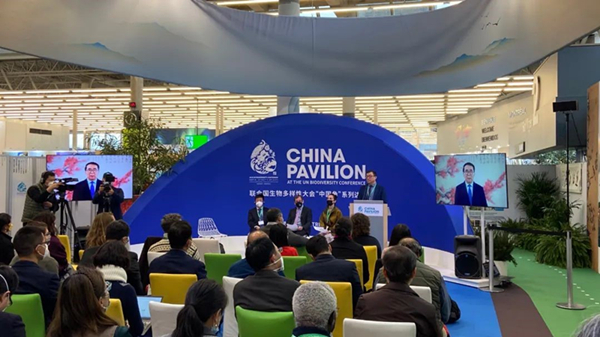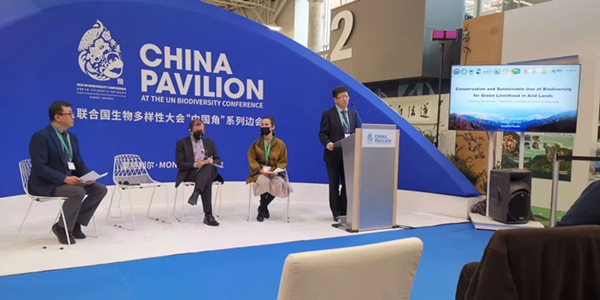XIEG Held a Side Event on “Conservation and Sustainable Use of Biodiversity for Green Livelihood in Arid Lands” during CBD COP15
2022-12-19
The Xinjiang Institute of Ecology and Geography, Chinese Academy of Sciences (XIEG) held a side event entitled “Conservation and Sustainable Use of Biodiversity for Green Livelihood in Arid Lands” on December 11 (Montreal time) during the second phase of the 15th Conference of the Parties (COP15) to the United Nations Convention on Biological Diversity (UNCBD). The event was held in collaboration with other scientific research institutions and international organizations, such as the Alliance of International Science Organizations (ANSO), the Administrative Center for China’s Agenda 21, the Foreign Environmental Cooperation Center of Ministry of Ecology and Environment of the People’s Republic of China (MEE), the Nanjing Institute of Environmental Sciences of the MEE, the Global Biodiversity Information Facility (GBIF), the International Center for Integrated Mountain Development (ICIMOD), the International Platform for Dryland Research and Education of Tottori University of Japan, the National Academy of Sciences of Tajikistan, the Institute of Biology of the National Academy of Sciences of the Kyrgyz Republic, the Institute of Zoology of the Republic of Kazakhstan and the Institute of Botany of the Academy of Sciences of Uzbekistan.

Bai Chunli makes a speech via video link.

Cui Shuhong delivers a speech.
In his opening remarks, academician Bai Chunli, president of ANSO, pointed out that most of the arid lands are located in developing countries that relatively lack policies for biodiversity conservation and sustainable use. The unique biodiversity has not received enough attention. It is thus urgent to strengthen international cooperation and prioritize the protection of arid lands around the globe. Cui Shuhong, director general of the Department of Nature and Ecology Conservation of the MEE, said that most of the arid areas are in developing countries, and that the relationship between conservation and livelihood should be properly handled in the biodiversity conservation in arid lands. He hoped that the participants of the event would share more experiences that could be used for reference and work together to promote the biodiversity protection in arid areas. Jamal Annagylyjova, program officer on forest biodiversity and dryland of the CBD Secretariat, said that the CBD Secretariat highly appreciates the efforts made by XIEG in promoting biodiversity conservation in arid lands in international forums. The MOU signed between XIEG and CBD Secretariat is a key measure to enhance international cooperation in biodiversity conservation in arid areas. The Secretariat looks forward to cooperating with XIEG in scientific research, capacity building and technology research and development in biodiversity of arid lands. Tim Hirsch, deputy director of the GBIF Secretariat, said that the arid lands account for about one third of the global land surface area and boast of rich and unique biodiversity, which is an important guarantee to support human livelihoods and well-being. It is urgent to step up biodiversity conservation in these areas to achieve sustainable development.

Jamal Annagylyjova delivers a speech.

Tim Hirsch delivers a speech.
During the invited presentation session, wonderful reports were given by Ke Bing, deputy director of the Administrative Center for China’s Agenda 21, professor Lise Korsten, co-director of the Science and Innovation Department of the Center of Excellence in Food Security of the National Research Foundation of South Africa, Li Yonghong, deputy director of the Foreign Environmental Cooperation Center of the MEE, professor Roman Jashenko, director of the Institute of Zoology of the Republic of Kazakhstan, Tim Hirsch, deputy director of the GBIF Secretariat, Ma Keping, research fellow of the Institute of Botany of Chinese Academy of Sciences, and Zhang Yuanming, research fellow and director of XIEG. They made presentations respectively entitled " Important Progress and Prospects of Biodiversity Conservation Supported by Science and Technology in China", "Conservation and Use of Arid Lands Biodiversity for Green Livelihood", "Support the Implementation of the CBD and Deepen International Cooperation on Biodiversity Conservation", "Biodiversity Conservation Alliance for Arid Land Conservation: Voice from Central Asia", "Open Biodiversity Data as a Tool for Conservation of Dryland Ecosystem", " Biodiversity Conservation Priority Areas in Arid Lands" and "Challenges and Solutions to Biodiversity Conservation in Arid Lands".
During the expert discussion, experts from South Africa, Spain, Uzbekistan, Turkmenistan, ICIMOD, and the Nanjing Institute of Environmental Sciences of the MEE actively exchanged ideas and shared the latest achievements and views on the main threats faced by the Succulent Karoo Biodiversity Hotspot, the biodiversity status quo of the Central Asian desert ecosystems, monitoring technologies of biodiversity in arid areas, successful cases of plant-soil conservation, the assessment of the relationship among the intergovernmental science policy platforms on biodiversity and ecosystem services.

Expert discussion
Rahimi Farhod, president of the National Academy of Sciences of Tajikistan, said in his speech at the closing ceremony that Tajikistan joined the UNCBD in 2004. The academy and the XIEG jointly established the Central Asian Ecological and Environmental Research Center (Dushanbe) in 2016 to carry out research on biodiversity conservation and utilization. He called on countries to shore up cooperation, increase investment in capital and human resources, and deal with biodiversity crises and various environmental problems through concerted efforts.
At the meeting, the XIEG, together with domestic and foreign scientific research institutions and international organizations, jointly launched the Biodiversity Conservation Alliance in Arid Lands (BCAA). Under the guidance of the CBD and its related protocols, the BCAA will pool the wisdom of scientists from multiple countries, focus on the status quo, problems and challenges of biodiversity conservation in arid lands, and conduct joint research on key issues such as mechanisms leading to species endangerment, improvement of ecosystem services, and conservation and sustainable development of biological resources in arid lands, etc.

The BCAA is launched.
XIEG director Zhang Yuanming said that the BCAA will become an international platform for governments, scientists and local communities to carry out project cooperation, knowledge sharing, capacity building and other activities in conservation and sustainable use of biodiversity in arid lands. In the future, XIEG will seize the opportunity of the second phase of COP15 and leverage the achievements of the meeting to cement the existing international cooperation foundation, further enhance and expand cooperation on biodiversity conservation with Central Asian and African countries under the Belt and Road Initiative. It will endeavor to contribute China’s wisdom, and apply successful Chinese solutions to all fields of biodiversity conservation in arid lands, facilitate the sharing of biodiversity information and benefits of biological resources, and jointly build a shared future for all life in arid lands.
The side event attracted extensive attention of scientists, institutions environmental protection organizations from many countries. Experts attending the event online and offline exchanged experiences on sustainable use of biological resources in arid lands, and shared innovative technologies and models that are operable and can improve local human livelihoods and well-being. They called on the international community to pay attention to and protect biodiversity in arid lands, promote cooperation among all stakeholders, respond to the initiative of the UN Decade on Ecosystem Restoration (2021-2030), and make positive contributions to the realization of CBD’s vision of "living in harmony with nature" by 2050.



